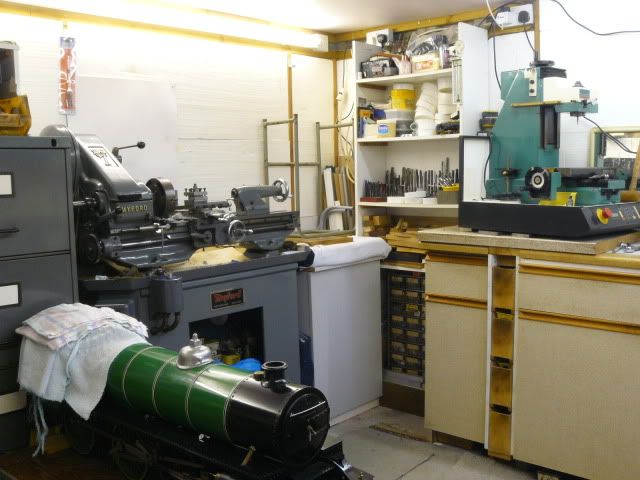Post by baggo on Jan 29, 2011 20:38:30 GMT
After dreaming of a proper workshop for the last few years, I've finally got around to planning it and making a start.
At the moment my workshop is the back bedroom of the house and houses the ML7 and the small Chester mill. Nice and cosy to work in, but, living in a semi limits the amount of noise I can make all day (and night) long! When I get the bit between my teeth I can be working on a project for 12 hours a day, 7 days a week!
The large Chester mill is relegated to outside under the carport which is far from ideal and it's beginning to suffer from the damp so needs a proper home. I've also gained an old Denham lathe that needs a home and that needs somewhere to live before I can collect it. I also seem to spend/waste a lot of time fetching and carrying tools from one place to another, so the time has finally come to do something about it and get everything in one place.
The new workshop will be outside in the garden and will be 4.9 metres by 2.9 metres, slightly under 15 square metres in area to avoid planning problems!
I decided from the outset that I was not having a concrete floor. It may well be better for standing heavy machines on but I just did not want the expense and the effort of laying 15 sq. metres of concrete.
Instead I have gone for a wooden sub floor of 28mm decking planks on 150 x 50 joists supported at regular intervals by concrete blocks. Once the shell is built, a second floor of 18mm exterior plywood or similar will be laid on the top. I reckon the whole thing will be plenty strong enough. The heaviest machine will be the Chester Eagle 25 mill and that is not all heavy really. It's unlikely that I will get anything bigger (famous last words!)
I did actually seriously consider a ready made shed and did find some at a quite reasonable price. The problem is that they all have quite weak floors and would have needed a solid base to sit on. I eventually decided that for a similar price I could build one slightly larger and of far stronger construction.
The framing will be 87mm x 38mm tanalised timber which apparently is called motorway rail! I presume it's used for constructing the many miles of motorway fencing but was very cheap compared to other sources of timber.
I eventually decided on steel cladding as opposed to timber. The cost is similar but the steel is much quicker to use and is practically maintenance free as it's galvanised and then plastic coated. I bought one of those steel flat pack sheds 10 years ago and it's still as good as new.
The walls and roof will be insulated and then lined with 10mm plywood. Should be warm and snug in winter. Actually it will probably be a lot warmer than the house and a lot cheaper to heat!
Anyway, enough waffling. The materials arrived in the middle of all that snow and it was some weeks before a start could be made. Progress has been slow and very hard work. The site for the workshop slopes quite a bit and I've had to dig out and move perhaps 10 tons of soil to get the floor level and as low as possible to get within the 2.5metre maximum height restriction.
All the main floor joists are now in position and all the supporting blocks in place. I've increased the number of blocks along the back wall where the machines will sit to make the floor as strong as possible. Next job is to lay the decking sub floor and then I can make a start on the framework.



At the moment my workshop is the back bedroom of the house and houses the ML7 and the small Chester mill. Nice and cosy to work in, but, living in a semi limits the amount of noise I can make all day (and night) long! When I get the bit between my teeth I can be working on a project for 12 hours a day, 7 days a week!
The large Chester mill is relegated to outside under the carport which is far from ideal and it's beginning to suffer from the damp so needs a proper home. I've also gained an old Denham lathe that needs a home and that needs somewhere to live before I can collect it. I also seem to spend/waste a lot of time fetching and carrying tools from one place to another, so the time has finally come to do something about it and get everything in one place.
The new workshop will be outside in the garden and will be 4.9 metres by 2.9 metres, slightly under 15 square metres in area to avoid planning problems!
I decided from the outset that I was not having a concrete floor. It may well be better for standing heavy machines on but I just did not want the expense and the effort of laying 15 sq. metres of concrete.
Instead I have gone for a wooden sub floor of 28mm decking planks on 150 x 50 joists supported at regular intervals by concrete blocks. Once the shell is built, a second floor of 18mm exterior plywood or similar will be laid on the top. I reckon the whole thing will be plenty strong enough. The heaviest machine will be the Chester Eagle 25 mill and that is not all heavy really. It's unlikely that I will get anything bigger (famous last words!)
I did actually seriously consider a ready made shed and did find some at a quite reasonable price. The problem is that they all have quite weak floors and would have needed a solid base to sit on. I eventually decided that for a similar price I could build one slightly larger and of far stronger construction.
The framing will be 87mm x 38mm tanalised timber which apparently is called motorway rail! I presume it's used for constructing the many miles of motorway fencing but was very cheap compared to other sources of timber.
I eventually decided on steel cladding as opposed to timber. The cost is similar but the steel is much quicker to use and is practically maintenance free as it's galvanised and then plastic coated. I bought one of those steel flat pack sheds 10 years ago and it's still as good as new.
The walls and roof will be insulated and then lined with 10mm plywood. Should be warm and snug in winter. Actually it will probably be a lot warmer than the house and a lot cheaper to heat!
Anyway, enough waffling. The materials arrived in the middle of all that snow and it was some weeks before a start could be made. Progress has been slow and very hard work. The site for the workshop slopes quite a bit and I've had to dig out and move perhaps 10 tons of soil to get the floor level and as low as possible to get within the 2.5metre maximum height restriction.
All the main floor joists are now in position and all the supporting blocks in place. I've increased the number of blocks along the back wall where the machines will sit to make the floor as strong as possible. Next job is to lay the decking sub floor and then I can make a start on the framework.









